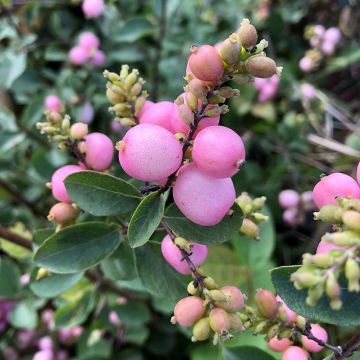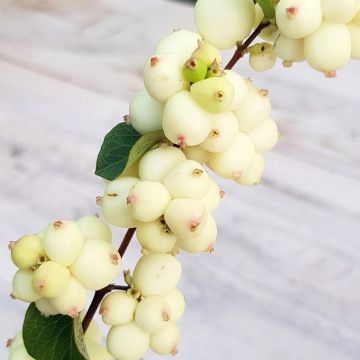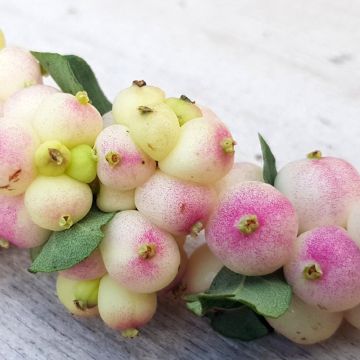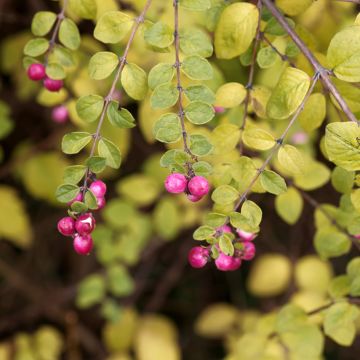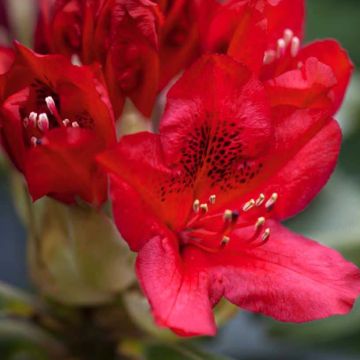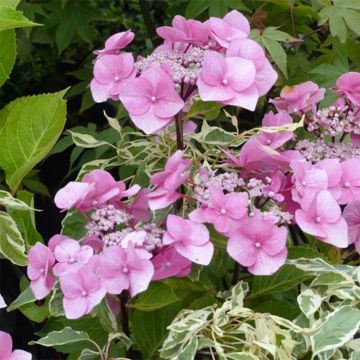

Symphoricarpos chen. Brain de Soleil®


Symphoricarpos chen. Brain de Soleil®
Symphoricarpos chenaultii Brain de Soleil
Symphorycarpos chenaultii Brain de Soleil®
Chenault Coralberry, Snowberry, Hancock Coralberry
Why not try an alternative variety in stock?
View all →This plant carries a 24 months recovery warranty
More information
We guarantee the quality of our plants for a full growing cycle, and will replace at our expense any plant that fails to recover under normal climatic and planting conditions.
From €5.90 for pickup delivery and €6.90 for home delivery
Express home delivery from €8.90.
Does this plant fit my garden?
Set up your Plantfit profile →
Description
The Syphoricarpos chenaultii 'Brain de Soleil' is a French variety and fairly recent cultivar of the Chenault's Snowberry. It is a mutation of the famous cultivar 'Hancok', with golden foliage and orange young shoots. Interesting for a good part of the year, adorned with beautiful colors in autumn and small white berries in winter, this deciduous, prostrate bush ultimately forms a robust and hardy ground cover that can withstand almost anything, but its growth can be easily controlled. This snowberry, with its warm and changing colors, proves to be valuable for greening difficult areas of the garden such as the understory of large trees or a sunny but slightly dry slope.
The Symphoricarpos x chenaultii belongs to the caprifoliaceae family, just like honeysuckles. This deciduous bush, discovered in Orléans in 1910 by R. Chenault, is a spontaneous hybrid between the Symphoricarpos microphyllus and S. orbiculatus, both native to the United States and Mexico. 'Hancock', found in Canada in 1950, is a prostrate form with beautiful vigor. In 2003, in Maine-et-Loire, 'Hancock' gave birth to a luminous cultivar with golden leaves through mutation, which was named 'Brain de Soleil'.
This snowberry has a low habit, both bushy, ramified, dense, and spreading. The bush is capable of lateral spreading through suckers and spontaneous layering, with its stems easily rooting upon contact with the soil. Where they interfere, they can be easily pulled out. Slow-growing, it reaches about 50-60 cm (20-24in) in height and 1.50 m (5ft) to 2 m (7ft) in width at maturity. In spring, the young shoots of 'Brain de Soleil' have a beautiful orange color. Then the stems turn yellow and develop small leaves 1 cm (<1in) to 1.5 cm (1in) long and 0.8 cm (<1in) to 1 cm (<1in) wide, of a golden yellow color that becomes more chartreuse in summer or in shade before turning coppery orange at the end of the season. Flowering takes place in the second half of May, in the form of small discreet flowers that are more or less white, greenish, and pink. It is followed by the formation of a few small, rather inconspicuous white berries.
Snowberries are known for their hardiness and beautiful winter fruiting. 'Brain de Soleil' will be appreciated more for its changing and luminous foliage, and for its willingness to cover the ground at the base of hedges and under large trees. Its small size also makes it ideal for slopes or flower beds, in combination with evergreen shrubs such as conifers or dwarf bamboos, prostrate cotoneasters, or other ground cover plants like Rhus aromatica Gro-Low for example. You can even grow the Brain de Soleil snowberry in a large pot on your terrace.
Report an error about the product description
Symphoricarpos chenaultii Brain de Soleil in pictures
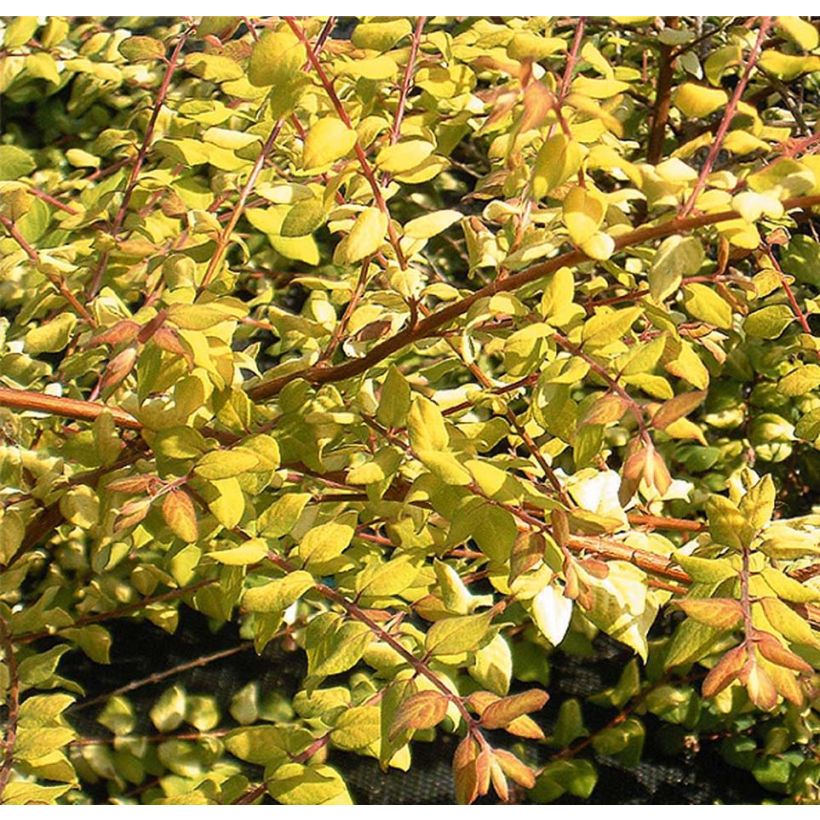

Plant habit
Flowering
Foliage
Botanical data
Symphorycarpos
chenaultii
Brain de Soleil®
Caprifoliaceae
Chenault Coralberry, Snowberry, Hancock Coralberry
Cultivar or hybrid
Other Symphoricarpos
Planting and care
The 'Brain de Soleil' Symphorine adapts to all exposures: it tolerates shade, but its foliage will be more colourful in partial shade or in the sun. It is a very hardy and easy to grow bush that suits any good garden soil. It even tolerates dry soils and soils filled with roots that are found under large trees and at the base of hedges. You can do a pruning in late winter to maintain balance. Optionally, remove the suckers to limit the growth of the bush, this operation is not difficult.
Planting period
Intended location
Care
-
, onOrder confirmed
Reply from on Promesse de fleurs
Shrubs for semi-shade
Haven't found what you were looking for?
Hardiness is the lowest winter temperature a plant can endure without suffering serious damage or even dying. However, hardiness is affected by location (a sheltered area, such as a patio), protection (winter cover) and soil type (hardiness is improved by well-drained soil).

Photo Sharing Terms & Conditions
In order to encourage gardeners to interact and share their experiences, Promesse de fleurs offers various media enabling content to be uploaded onto its Site - in particular via the ‘Photo sharing’ module.
The User agrees to refrain from:
- Posting any content that is illegal, prejudicial, insulting, racist, inciteful to hatred, revisionist, contrary to public decency, that infringes on privacy or on the privacy rights of third parties, in particular the publicity rights of persons and goods, intellectual property rights, or the right to privacy.
- Submitting content on behalf of a third party;
- Impersonate the identity of a third party and/or publish any personal information about a third party;
In general, the User undertakes to refrain from any unethical behaviour.
All Content (in particular text, comments, files, images, photos, videos, creative works, etc.), which may be subject to property or intellectual property rights, image or other private rights, shall remain the property of the User, subject to the limited rights granted by the terms of the licence granted by Promesse de fleurs as stated below. Users are at liberty to publish or not to publish such Content on the Site, notably via the ‘Photo Sharing’ facility, and accept that this Content shall be made public and freely accessible, notably on the Internet.
Users further acknowledge, undertake to have ,and guarantee that they hold all necessary rights and permissions to publish such material on the Site, in particular with regard to the legislation in force pertaining to any privacy, property, intellectual property, image, or contractual rights, or rights of any other nature. By publishing such Content on the Site, Users acknowledge accepting full liability as publishers of the Content within the meaning of the law, and grant Promesse de fleurs, free of charge, an inclusive, worldwide licence for the said Content for the entire duration of its publication, including all reproduction, representation, up/downloading, displaying, performing, transmission, and storage rights.
Users also grant permission for their name to be linked to the Content and accept that this link may not always be made available.
By engaging in posting material, Users consent to their Content becoming automatically accessible on the Internet, in particular on other sites and/or blogs and/or web pages of the Promesse de fleurs site, including in particular social pages and the Promesse de fleurs catalogue.
Users may secure the removal of entrusted content free of charge by issuing a simple request via our contact form.
The flowering period indicated on our website applies to countries and regions located in USDA zone 8 (France, the United Kingdom, Ireland, the Netherlands, etc.)
It will vary according to where you live:
- In zones 9 to 10 (Italy, Spain, Greece, etc.), flowering will occur about 2 to 4 weeks earlier.
- In zones 6 to 7 (Germany, Poland, Slovenia, and lower mountainous regions), flowering will be delayed by 2 to 3 weeks.
- In zone 5 (Central Europe, Scandinavia), blooming will be delayed by 3 to 5 weeks.
In temperate climates, pruning of spring-flowering shrubs (forsythia, spireas, etc.) should be done just after flowering.
Pruning of summer-flowering shrubs (Indian Lilac, Perovskia, etc.) can be done in winter or spring.
In cold regions as well as with frost-sensitive plants, avoid pruning too early when severe frosts may still occur.
The planting period indicated on our website applies to countries and regions located in USDA zone 8 (France, United Kingdom, Ireland, Netherlands).
It will vary according to where you live:
- In Mediterranean zones (Marseille, Madrid, Milan, etc.), autumn and winter are the best planting periods.
- In continental zones (Strasbourg, Munich, Vienna, etc.), delay planting by 2 to 3 weeks in spring and bring it forward by 2 to 4 weeks in autumn.
- In mountainous regions (the Alps, Pyrenees, Carpathians, etc.), it is best to plant in late spring (May-June) or late summer (August-September).
The harvesting period indicated on our website applies to countries and regions in USDA zone 8 (France, England, Ireland, the Netherlands).
In colder areas (Scandinavia, Poland, Austria...) fruit and vegetable harvests are likely to be delayed by 3-4 weeks.
In warmer areas (Italy, Spain, Greece, etc.), harvesting will probably take place earlier, depending on weather conditions.
The sowing periods indicated on our website apply to countries and regions within USDA Zone 8 (France, UK, Ireland, Netherlands).
In colder areas (Scandinavia, Poland, Austria...), delay any outdoor sowing by 3-4 weeks, or sow under glass.
In warmer climes (Italy, Spain, Greece, etc.), bring outdoor sowing forward by a few weeks.





































